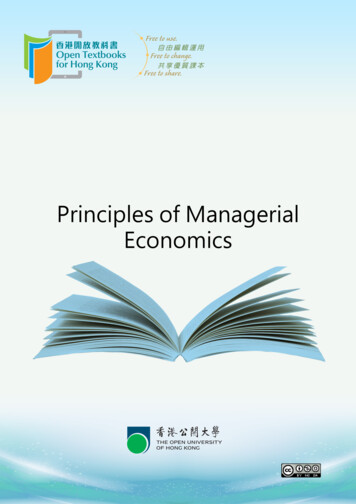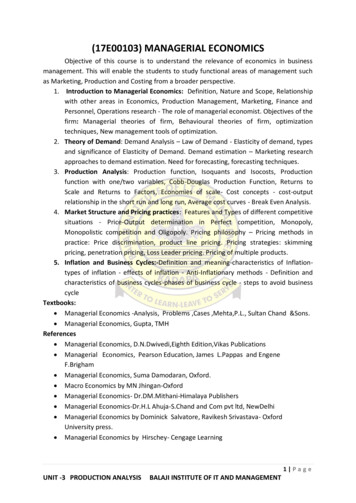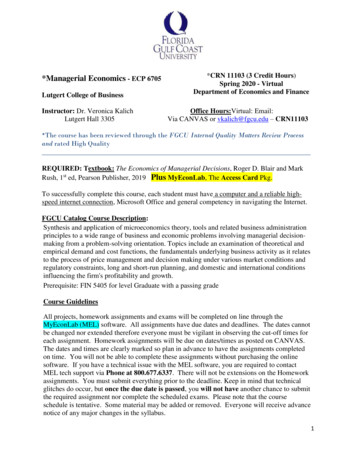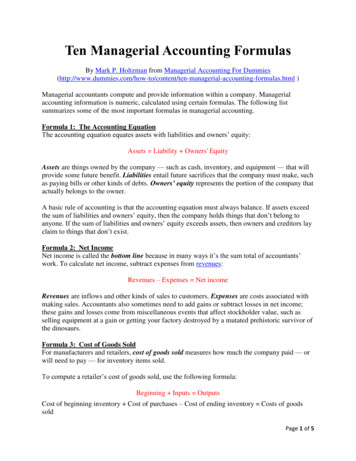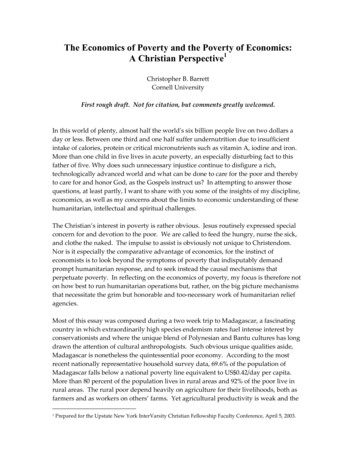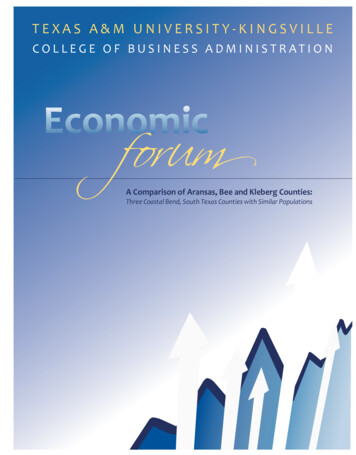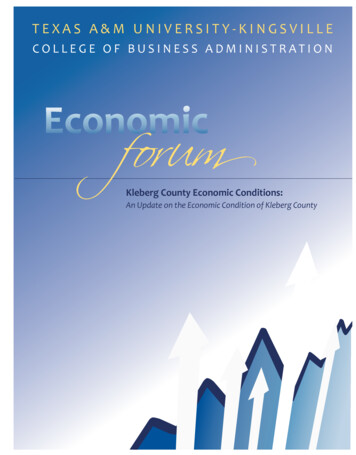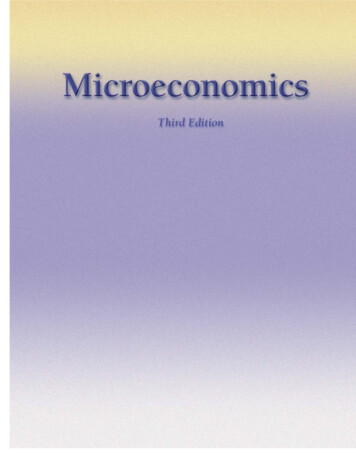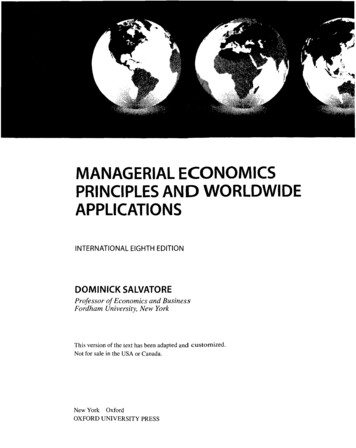
Transcription
MANAGERIAL ECONOMICSPRINCIPLES AND WORLDWIDEAPPLICATIONSINTERNATIONAL EIGHTH EDITIONDOMINICK SALVATOREProfessor of Economics and BusinessFordham University, New YorkThis version of the text has been adapted and customized.Not for sale in the USA or Canada.New York OxfordOXFORD UNIVERSITY PRESS
CONTENTSPreface xxxiPART ONEINTRODUCTION1CHARTER 1 The Nature and Scope of Managerial Economics 31-1 The Scope of Managerial Economics 4Definition of Managerial Economics 4Relationship to Economic Theory 6Relationship to the Decision Sciences 6Relationship to the Functional Areas of Business Administration Studies 71-2 The Basic Process of Decision Making 7CASE STUDY 1-1 Peter Drucker—The Man Who Invented Management 9CASE STUDY 1-2 The Management Revolution 101-3 The Theory of the Firm 10Reasons for the Existence of Firms and Their Functions 11The Objective and Value of the Firm 12Constraints on the Operation of the Firm 13Limitation: of the Theory of the Firm 141-4 The Nature and Function of Profits 15Business versus Economic Profit 15Theories of Profit 16Function of Profit 171-5 Business Ethics 18CASE STUDY 1-3 The Global Financial Crisis 201-6 The International Framework of Managerial Economics 20CASE STUDY 1-4 The Rise of the Global Corporation 211-7 Managerial Economics in a More Risky, Crisis-Prone,and Sluggish Global Economy 22CASE STUDY 1 5 The Global Business Leader 23CASE STUDY 1-6 Global Most Admired Companies 24xiii
1-8 Managerial Economics and the Internet 26CASE STUDY 1-7 The Most Important Internet Site Addressesfor Managerial Economics 27Summary « ProblemsAppendix to Chapter 1 The Basics of Demand, Supply, and Equilibrium 30The Demand Side of the Market 30The Supply Side of the Market 31The Equilibrium Price 31Shift in the Demand Curve and Equilibrium 32Shift in the Supply Curve and Equilibrium 32Appendix Problems Supplementary ReadingsCHAPTER 2 Optimization Techniques and New Management Tools 352-1 Methodsof Expressing Economic Relationships 372-2 Total, Average, and Marginal Relationships 38Total, Average, and Marginal Cost 38Geometrie Derivation of the Average- and Marginal-Cost Curves402-3 Optimization Analysis 41Profit Maximization by the Total-Revenue and Total-Cost Approach 41Optimization by Marginal Analysis 41CASE STUDY 2-1 Optimal Pollution Control 432-4 Constrained Optimization 442-5 New Management Tools for Optimization 44Benchmarking 44CASE STUDY 2-2 Pursuing Multiple Objectives under Constraintsby Global Corporations 45CASE STUDY 2-3 Benchmarking at Xerox, Ford, and Mobil 46Total Quality Management 47CASE STUDY 2-4 Total Quality Management at Johnson & Johnson, Motorola,General Electric, and Ford 48Reengineering 49CASE STUDY 2-5 Reengineering at GE 50The Learning Organization 50CASE STUDY 2-6 Applying Learning-Organization Principles at Fordand Southwest Airlines 51
CONTENTS2-6 Other Management Tools for Optimization 522-7 New Management Tools and Functional Specialization 54CASE STUDY 2-7 The American Business Model 55CASE STUDY 2-8 When Governance Rules Fail, PublicTrust Is Eroded 56BOX 1 Managerial Economics at Work: ManagementPractices across the World 57Summary Problems Spreadsheet ProblemsAppendix 1 to Chapter 2 Optimization Using Spreadsheets 60Appendix ProblemAppendix 2 to Chapter 2 Differential Calculus and OptimizationTechniques 62The Derivative and Rules of Differentiation 62The Concept of the Derivative 62Rules of Differentiation 63Optimization with Calculus 67Determining a Maximum or a Minimum by Calculus 68Distinguishing between a Maximum and a Minimum: The SecondDerivative 68Multivariate Optimization 70Partial Derivatives 70Maximizing a Multivariable Function 71Constrained Optimization 72Constrained Optimization by Substitution 72Constrained Optimization by the Lagrangian MultiplierMethod 73Appendix Problems Supplementary ReadingsINTEGRATING CASE STUDY 1 Steve Jobs: A Genius Departs—The AstonishingCareer of the World's Most Revered Chief Executive 77Three-Way Marriage 78Oh, and One More Thing 79PARTTWODEMANP ANALYSIS81CHAPTER 3 Demand Theory 833-1 The Demand for a Commodity 85An IndividuaPs Demand for a Commodity 85From Individual to Market Demand 88XV
XVICONTENTSCASE STUDY 3-1 The Demand for Big Macs 90The Demand Faced by a Firm 913-2 Price Elasticity of Demand 93Point Price Elasticity of Demand 94Are Price Elasticity of Demand 96Price Elasticity, Total Revenue, and Marginal Revenue 97Factors Affecting the Price Elasticity of Demand 1013-3 Income Elasticity of Demand 101CASE STUDY 3-2 Price Elasticities of Demand in the Real World 102CASE STUDY 3-3 Income Elasticities of Demand in the Real World 1043-4 Cross-Price Elasticity of Demand 1053-5 Using Elasticities in Managerial Decision Making 107CASE STUDY 3-4 Cross-Price Elasticities of Demand in the Real World 108CASE STUDY 3-5 Substitution between Domestic and Foreign Goods 109BOX 2 Managerial Economics at Work: Decision Time at the AromaticCoffee Company 1103-6 International ConvergenceofTastes IIICASE STUDY 3-6 Gillette Introduces Space-Technology Global Razors 112CASE STUDY 3-7 Ford's World Car(s) 1133-7 Electronic Commerce 114CASE STUDY 3-8 E-Commerce at Amazon.com 116CASE STUDY 3-9 Amazon Puts an End to eBay Star Performance 118Summary Problems Spreadsheet ProblemsAppendix to Chapter 3 Behind the Market Demand Curve—The Theory of Consumer Choice 122The Consumer's Tastest Indifference Curves 123The Consumer's Constraints: The Budget Line 124The Consumer's Equilibrium 124Derivation of the Consumer's Demand Curve 125Income and Substitution Effects of a Price Change 125The Theory of Consumer Choice Mathematically 127Appendix Problems Supplementary Readings
CONTENTSCHAPTER 4 Demand Estimation 1294-1 The Identification Problem 1314-2 Marketing Research Approaches to Demand Estimation 133Consumer Surveys and Observational Research 133CASE STUDY 4-1 Micromarketing: Marketers Zero in on Their Customers 134Consumer Clinics 135Market Experiments 136CASE STUDY 4-2 Estimation of the Demandfor Oranges by Market Experiment 137Virtual Shopping and Virtual Management 137CASE STUDY 4-3 Reaching Consumers in the Vanishing Mass Market 1394-3 Introduction to Regression Analysis 1404-4 Simple Regression Analysis 143The Ordinary Least-Squares Method 143Tests of Significance of Parameter Estimates 145Other Aspects of Significance Tests and Confidence Intervals 147Test of Goodness of Fit and Correlation 1484-5 Multiple Regression Analysis 152The Multiple Regression Model 152The Coefficient of Determination and Adjusted R2 154Analysis of Variance 155Point and Interval Estimates 1564-6 Problems in Regression Analysis 157Multicollinearity 157Heteroscedasticity 157Autocorrelation 1594-7 Demand Estimation by Regression Analysis 160Model Specificiation 160Collecting Data on the Variables 161Specifying the Form of the Demand Equation 161Testing the Econometric Results 1634-8 Estimating the Demand for U.S. Imports and Exports 163CASE STUDY 4-4 Estimation of the Demand for Air Travelover the North Atlantic 164CASE STUDY 4-5 Price and Income Elasticities of Importsand Exports in the Real World 165BOX 3 Managerial Economics at Work: BlackBerry Crumbles 166XVÜ
Summary ProblemsAppendix to Chapter 4 Regression Analysis with Excel 172Simple Regression 172Multiple Regression Analysis 174Appendix Problems Supplementary ReadingsCHAPTER 5 Demand Forecasting 1775-1 Qualitative Forecasts 179Survey Techniques 179Opinion Polls 180Soliciting a Foreign Perspective 181CASE STUDY 5-1 Forecasting the Number ofMcDonald's Restaurants Worldwide 1815-2 Time-Series Analysis 182Reasons for Fluctuations in Time-Series Data 183Trend Projection 184Seasonal Variations 187CASE STUDY 5 2 Forecasting New-Housing Startswith Time-Series Analysis 1895-3 Smoothing Techniques 190Moving Averages 190Exponential Smoothing 192CASE STUDY 5-3 Forecasting Lumber Saleswith Smoothing Techniques 1945-4 Barometric Methods 195CASE STUDY 5-4 Forecasting the Level of Economic Activitywith Composite and Diffusion Indexes 199CASE STUDY 5-5 The Index of Leading Indicators Goes Global 1995-5 Econometric Models 200Single-Equation Models 200CASE STUDY 5-6 Forecasting the Demand for Air Travelover the North Atlantic 201Multiple-Equation Models 202CASE STUDY 5-7 Economic Forecasts with LargeEconometric Models 204
CONTENTSBOX 4 Managerial Economics at Work:Risks in Demand Forecasting 2055-6 Input-Output Forecasting 206Summary ProblemsAppendix to Chapter 5 Forecasting Fluctuations in Time-SeriesAnalysis Using Excel 211Forecasting New-Housing Starts with RegressionAnalysis 211Adjusting the Trend Forecasts of New-Housing Startsfor Seasonal Variations by the Ratio-to-Trend Method 213Adjusting the Trend Forecasts of New-Housing Startsfor Seasonal Variations by Using Seasonal Dummies 215Appendix Problems Supplementary ReadingsINTEGRATING CASE STUDY 2 Ford's Bet: It's a SmallWorld After All 219Ford in the U.S. Automobile Industry 219Staking Ford's Future 220Epilogue 220INTEGRATING CASE STUDY 3 Estimating and Forecastingthe U.S. Demand for Electricity 222PARTTHREEPRODUCTION AND COST ANALYSIS225CHAPTER 6 Production Theory and Estimation2276-1 The Organization of Production and the Production Function 229The Organization of Production 229The Production Function 2306-2 The Production Function with One Variable Input 233Total, Average, and Marginal Product 233The Law of Diminishing Returns and Stages of Production 2356-3 Optimal Use of the Variable Input 2376-4 The Production Function with Two Variable Inputs 239Production Isoquants 239Economic Region of Production 241Marginal Rate of Technical Substitution 242Perfect Substitutes and Complementary Inputs 243xix
6-5 Optimal Combination of Inputs 245Isocost Lines 245Optimal Input Combination for Minimizing Costs or Maximizing Output 246Profit Maximization 248Effect of Change in Input Prices 249CASE STUDY 6-1 Substitutability between Gasoline Consumptionand Driving Time 2506-6 Returns to Scale 251CASE STUDY 6-2 General Motors Decides Smaller Is Better 2536-7 Empirical Production Functions 254CASE STUDY 6-3 Output Elasticities in U.S. Manufacturing Industries 2556-8 The Innovation Process 256Meaning and Importance of Innovations 256CASE STUDY 6-4 How Do Firms Get New Technology? 258How Innovative Is Your Company's Culture? 258The Open Innovation Model 259CASE STUDY 6-5 Open Innovations at Procter & Gamble 260The Next Step in Open Innovation 2616-9 Innovation and Global Competitiveness 262Innovations and the International Competitiveness of U.S. Firms 262BOX 5 Managerial Economics at Work: How Xerox Lostand Regained International Competitiveness and Became a Leaderin Information Technology 263The New Computer-Aided Production Revolution, 3-D Printing,and the International Competitiveness of U.S. Firms 264CASE STUDY 6-6 The Euro and the InternationalCompetitiveness of European Firms 265Summary Problems « Spreadheet ProblemsAppendix to Chapter 6 Production Analysis with Calculus 270Constrained Output Maximization 270Constrained Cost Minimization 271Profit Maximization 272Appendix Problems » Supplementary Readings
CONTENTSXXiCHAPTER 7 Cost Theory and Estimation 2747-1 The Nature ofCosts 2767-2 Short-Run Cost Functions 277Short-Run Total and Per-Unit Cost Functions 277Short-Run Total and Per-Unit Cost Curves 2787-3 Long-Run Cost Curves 281Long-Run Total Cost Curves 281Long-Run Average and Marginal Cost Curves 283CASE STUDY 7-1 The Long-Run Average CostCurve in Electricity Generation 2857-4 Plant Size and Economies of Scale 286CASE STUDY 7-2 The Shape of the Long-Run Average Cost Curvesin Various Industries 2887-5 Leaming Curves 289CASE STUDY 7-3 To Reduce Costs, Firms Often Look Far Afieid 2917-6 Minimizing Costs Internationally—The New Economies of Scale 292International Trade in Inputs 292The New International Economies of Scale 293Immigration of Skilied Labor 2947-7 LogisticsorSupply-Chain Management 295CASE STUDY 7-4 Logistics at National Semiconductors, Saturn, and Compaq 2967-8 Cost-Volume-Profit Analysis and Operating Leverage 297Cost-Volume-Profit Analysis 297Operating Leverage 299CASE STUDY 7-5 Breakeven Analysis for Lockheed's Tri-Starand Europe's Airbus Industrie 3017-9 Empirical Estimation of Cost Functions 302Data and Measurement Problems in Estimating Short-Run Cost Functions 302The Functional Form of Short-Run Cost Functions 304CASE STUDY 7-6 Estimates of Short-Run and Long-Run Cost Functions 305Estimating Long-Run Cost Functions with Cross-Sectional RegressionAnalysis 306Estimating Long-Run Cost Functions with Engineeringand Survival Techniques 308Summary Problems Spreadsheet Problems
XXÜCONTENTSAppendix to Chapter 7 Cost Analysis with Calculus 313Appendix Problems Supplementary ReadingsINTEGRATING CASE STUDY 4 Production and Cost Functions in the PetroleumIndustry 317INTEGRATING CASE STUDY 5 The Third Industrial Revolution 320Toward a Third Dimension 320The Shock of the New 321INTEGRATING CASE STUDY 6 Toyota: The Machine That Ran Too Hot 322PART FOURMARKET STRUCTURE AND PRICING PRACTICES325CHAPTER 8 Market Structure: Perfect Competition, Monopoly,and Monopolistic Competition 3278-1 Market Structure and Degreeof Competition 3288-2 Perfect Competition 329Meaning and Importance of Perfect Competition 330Price Determination under Perfect Competition 330CASE STUDY 8-1 Competition in the New York Stock Market 331Short-Run Analysis of a Perfectly Competitive Firm 333Short-Run Supply Curve of the Competitive Firm and Market 336Long-Run Analysis of a Perfectly Competitive Firm 336CASE STUDY 8-2 Long-Run Adjustment in the U.S. CottonTextile Industry 3388-3 Competition in the Global Economy 339Domestic Demand and Supply, Imports, and Prices 339The Dollar Exchange Rate and the International Competitivenessof U.S. Firms 340CASE STUDY 8-3 The Exchange Rate of the U.S. Dollar and theProfitability of U.S. Firms 3428-4 Monopoly 343Sources of Monopoly 343CASE STUDY 8-4 Barriers to Entry and Monopoly by Alcoa 344Short-Run Price and Output Determination under Monopoly 345Long-Run Price and Output Determination under Monopoly 347Comparison of Monopoly and Perfect Competition 348BOX 6 Managerial Economics at Work: De Beers Abandons ItsDiamond Monopoly 350
CONTENTSXXÜi8-5 MortopolisticCompetition 352Meaning and Importance of Monopolistic Competition 352CASE STUDY8-5 The Monopolistically CompetitiveRestaurant Market 353Short-Run Price and Output Determination underMonopolistic Competition 353Long-Run Price and Output Determination underMonopolistic Competition 354Product Variation and Selling Expenses under Monopolistic Competition 356CASE STUDY 8-6 Advertisers Are Taking on Competitorsby Name. and Being Sued 356Summary Problems Spreadsheet ProblemsAppendix to Chapter 8 Profit Maximization with Calculus 362Appendix Problems Supplementär/ ReadingsCHAPTER 9 Oligopoly and Firm Architecture 3669-1 Oligopoly and Market Concentration 367Oligopoly: Meaning and Sources 367CASE STUDY 9-1 Brands: Thriveor Die 369Concentration Ratios, the Herfindahl Index, and Contestable Markets 370CASE STUDY 9-2 Industrial Concentration in the United States 3719-2 Oligopoly Models 372The Cournot Model 372The Kinked Demand Curve Model 374Carte! Arrangements 376CASE STUDY 9-3 The Organization of PetroleumExporting Countries (OPEC) Cartel 377Price Leadership 3789-3 Profitability and Efficiency Implications of Oligopoly 380Porter's Strategie Framework 380Efficiency Implications of Oligopoly 381CASE STUDY 9-4 Firm Size and Profitability 382CASE STUDY 9-5 Measuring the Pure Efficiency of Operating Units 3839-4 The Sales Maximization Model 384
9-5 The March of Global Ollgopolists 385CASE STUDY 9-6 The Globalizationofthe Automobile Industry 387CASE STUDY 9-7 Aising Competition in Global Banking 388CASE STUDY 9-8 The Globalization of the Pharmaceutical Industry 390BOX 7 Managerial Economics at Work: Multinational Corporations Follow BetterManagement Practices Than National Corporations 3919-6 The Architecture of the Ideal Firm and the Creative Company 392The Architecture of the Ideal Firm 392The Evolution of the Creative Company 394CASE STUDY 9-9 Firm Architecture and Organizational Competitivenessof High-Performance Organizations 395CASE STUDY 9-10 The Most Innovative Companies in the World 3969-7 The Virtual Corporation and Relationship Enterprises 397The Virtual Corporation 397Relationship Enterprises 398CASE STUDY 9-11 Relationship Enterprises in Aerospace, Airlines,Telecommunications, and Automobiles 399Summary Problems Spreadsheet ProblemsAppendix to Chapter 9 Oligopoly Theory Mathematically 403The Cournot Model 403The Kinked Demand Curve Model 406The Centralized Cartel Model 407The Market-Sharing Cartel 408The Sales Maximization Model 409Appendix Problems Supplementary ReadingsCHAPTER 10 Game Theory and Strategie Behavior 41310-1 Strategie Behavior and GameTheory 414CASE STUDY 10-1 Military Strategy and Strategie Business Decisions 41510-2 Dominant Strategy and Nash Equilibrium 416Dominant Strategy 416Nash Equilibrium 417CASE STUDY 10-2 Dell Computers and Nash Equilibrium 41910-3 The Prisoners' Dilemma 420
CONTENTSXXV10-4 Price and Nonprice Competition, Cartel Cheating, and Prisoners' Dilemma 421Price Competition and the Prisoners' Dilemma 421Nonprice Competition, Cartel Cheating, and the Prisoners' Dilemma 42210-5 Repeated Games and Tit-for-Tat Strategy 42210-6 Strategie Moves 423Threat, Commitments, and Credibility 423Entry Deterrence 424CASE STUDY 10-3 Wal-Mart's Preemptive Expansion Marketing Strategy 42510-7 Strategie Behavior and International Competitiveness 426BOX 8 Managerial Economics at Work: Companies'Strategie Mistakes and Faiiures 42810-8 Sequential Games and Decision Trees 429CASE STUDY 10-4 Airbus's Decision to Build the A380 and Boeing':Sonic Cruiser Response and the 747-8 431Summary Problems Spreadsheet Problems Supplementary ReadingsCHARTER 11 Prlcing Practices 43711-1 Pricing of Multiple Products 438Pricing of Products with Interrelated Demands 439Plant Capacity Utilization and Optimal Product Pricing 440Optimal Pricing of Joint Products Produced in Fixed Proportions 442Optimal Pricing and Output of Joint Products Produced in VariableProportions 443CASE STUDY 11-1 Optimal Pricing and Output by Gillette 44511-2 Price Discrimination 446Meaning of and Conditions for Price Discrimination 446First- and Second-Degree Price Discrimination 448Third-Degree Price Discrimination Graphically 449CASE STUDY 11-2 Price Discrimination by Con Edison 451Third-Degree Price Discrimination Algebraically 45211-3 International Price Discrimination and Dumping 45411-4 Transfer Pricing 455Meaning and Nature of Transfer Pricing 455Transfer Pricing with No External Market for the Intermediate Product 456
XXViCONTENTSTransfer Pricing with a Perfectly Competitive Marketfor the Intermediate Product 457Transfer Pricing with an Imperfectly Competitive Marketfor the Intermediate Product 459CASE STUDY 11-3 Transfer Pricing by MultinationalOperating in Emerging Markets 461CASE STUDY 11-4 Transfer Pricing in Advanced Countries 46211-5 Pricing in Practice 462Cost-Plus Pricing 463Evaluation of Cost-Plus Pricing 463Incremental Analysis in Pricing 465CASE STUDY 11-5 Incremental Pricing at Continental Airlines 466Peak-Load Pricing, TVo-Part Tariff, Tying, and Bundling 467Other Pricing Practices 468CASE STUDY 11-6 Bundling in the Leasing of Movies 469CASE STUDY 11-7 No-Haggling Value Pricing in Car Buying 471CASE STUDY 11-8 Name Your Price at Priceline 471Summary Problems Spreadsheet ProblemsAppendix to Chapter 11 Third-Degree Price Discrimination with Calculus 476Appendix Problems Supplementary ReadingsINTEGRATING CASE STUDY 7 eBay and Competition on the Internet 481No Safe Hävens 481Customers Behind the Wheel 482INTEGRATING CASE STUDY 8 Has Apple Peaked and Are Its BestDays Behind It? 483INTEGRATING CASE STUDY 9 Pricing on the Internet 485PART F1VEREGULATION, RtSK ANALYSIS, AND CAPITAL BUDGETINGCHAPTER 12 Regulation and Antitrust: The Roleof Government in the Economy 48912-1 Government Regulation to Support Business and toProtect Consumers,Workers, and the Environment 491Government Regulations That Restrict Competition 491Government Regulations to Protect Consumers, Workers,and the Environment 492CASE STUDY121 Regulation Greatly Reduced Air Pollution 494487
CONTENTS12-2 Externalities and Regulation 495The Meaning and Importance of Externalities 495Policies to Deal with Externalities 49712-3 Public Utility Regulation 499Public Utilities as Natural Monopolies 499CASE STUDY 12-2 The Market for Dumping Rights 500Difficulties in Public Utility Regulation 50212-4 Antitrust: Government Regulation of Market Structure and Conduct 503Sherman Act (1890) 504Clayton Act (1914) 504Federal Trade Commission Act (1914) 505Robinson-Patman Act (1936) 505Wheeler-Lea Act (1938) 505Celler-Kefauver Antimerger Act (1950) 50512-5 Enforcement of Antitrust Laws and the Deregulation Movement 505Enforcement of Antitrust Laws: Some General Observation 506Enforcement of Antitrust Laws: Structure 506CASE STUDY 12-3 The IBM and AT&T Cases 507CASE STUDY 12-4 Antitrust and the New Merger Boom 509Enforcement of Antitrust Laws: Conduct 510CASE STUDY 12-5 The Microsoft Antitrust Case 511The Deregulation Movement 512CASE STUDY 12-6 Deregulation of the Airline Industry: An Assessment 51412-6 Regulation of International Competition 515CASE STUDY 12-7 Voluntary Export Restraints on Japanese Automobilesto the United States 51712-7 The Effect of Taxation on Business Decisions 517BOX 9 Managerial Economics at Work: Corporate Tax Ratesaround the World and Multinational' Behavior 518Summary Problems Spreadsheet Problems Supplementary ReadingsCHARTER 13 Risk Analysis 52513-1 Risk and Uncertainty in Managerial Decision Making 527CASE STUDY 13-1 The Risk Faced by Coca-Cola in ChangingIts Secret Formula 528XXVÜ
xxviiiCONTENTS13-2 Measuring Risk with Probability Distribution; 528Probability Distribution: 529An Absolute Measure of Risk: The Standard Deviation 531Measuring Probabilities with the Normal Distribution 533A Relative Measure of Risk: The Coefficient of Variation 534CASE STUDY 13-2 RiskMetrics: A Method of MeasuringValue at Risk 53513-3 Utility Theory and Risk Aversion 536CASE STUDY 13-3 The Purchase of Insurance and Gambling by the SameIndividual—A Seeming Contradiction 53913-4 Adjusting the Valuation Model for Risk 540Risk-Adjusted Discount Rates 541Certainty-Equivalent Approach 543CASE STUDY 13-4 Adjusting the Valuation Model forRisk in the Real World 54513-5 OtherTechniques for Incorporating Risk into Decision Making 546Decision Trees 546Simulation 54813-6 Decision Making under Uncertainty 549The Maximin Criterion 549The Minimax Regret Criterion 550Other Methods of Dealing with Uncertainty 551CASE STUDY 13-5 Spreading Risks in the Choice of a Portfolio 55213-7 Foreign-Exchange Risks and Hedging 553CASE STUDY 13-6 Information, Risk, and the Collapse of Long-TermCapital Management 55513-8 Information and Risk 556Asymmetrie Information and the Market for Lemons 556The Insurance Market and Adverse Selection 557The Problem of Moral Hazard 557The Principal-Agent Problem 558CASE STUDY 13-7 Do Golden Parachutes Reward Failure? 559Auctions 560CASE STUDY 13-8 Auctioning of the Airwaves 561Summary Problems Spreadsheet Problems Supplementary Readings
CONTENTSCHARTER 14 Long-Run Investment Decisions: Capital Budgeting 57014-1 Capital Budgeting: An Overview 571Meaning and Importance of Capital Budgeting 571Overview of the Capital Budgeting Process 573CASE STUDY 14-1 Cost-Benefit Analysis and the SST 57514-2 The Capital Budgeting Process 575Projecting Cash Flows 575CASE STUDY 14-2 The Eurotunnel: Another Bad French-BritishInvestment? 576Net Present Value (NPV) 578Internal Rate of Return (IRR) 579Comparison of NPV and IRR 579CASE STUDY 14-3 Pennzoil's 3 Billion Capital Budgeting Challenge 580CASE STUDY 14-4 Capital Budgeting for Investments inHuman Capital 581BOX 10 Managerial Economics at Work: Is a CollegeEducation Still Worth It? 58214-3 Capital Rationing and the Profitability Index 58314-4 The Cost of Capital 585The Cost of Debt 585The Cost of Equity Capital: The Risk-Free Rate Plus Premium 585The Cost of Equity Capital: The Dividend Valuation Model 586The Cost of Equity Capital: The Capital Asset PricingModel (CAPM) 587The Weighted Cost of Capital 58914-5 Reviewing Investment Projects After Implementation 589CASE STUDY 14-5 The Choice between Equity and Debt 59014-6 The Cost of Capital and International Competitiveness 591Summary Problems Spreadsheet Problems Supplementary ReadingsINTEGRATING CASE STUDY 10 How Silicon ValleyConquered the Carriers 597INTEGRATING CASE STUDY 11 Technology Giants at War 599The Iron Phone 599Search Engines and Siege Engines 599Content-Maesters 600Stark Realities 601xxix
XXXCONTENTSAPPENDIXES603APPENDIX AA-1A-2A-3A-4A-5A-6A-7COMPOUNDING, DISCOUNTING, AND PRESENT VALUE 605Future Value and Compounding 605Presen! Value and Discounting 607Future Value of an Annuity 607Present Value of an Annuity 608Compounding and Discounting Periods 608Determining the Internst Rate 609Perpetuities 609APPENDIX B INTEREST FACTOR TABLES 611TABLE B-1 Compound Value of 1 612TABLE B-2 Present Value of 1 613TABLE B-3 Future Value of an Annuity of 1 for n Periods 614TABLE B-4 Present Value of an Annuity of 1 for n Periods 615APPENDIX C STATISTICAL TABLES 616TABLE C-l Areas under the Standard Normal Distribution 617TABLE C-2 Areas in the Tails of the t Distribution 618TABLE C-3 F Distribution for 5 Percent and 1 Percent Significance 619TABLE C-4 Durbin-Watson Statistic for 5 Percent and 1 Percent SignificancePoints of dL and du 621APPENDIX D ANSWERS TO SELECTED (ASTERISKED) PROBLEMS 623Glossary 653Index 667
MANAGERIAL ECONOMICS PRINCIPLES AND WORLDWIDE APPLICATIONS INTERNATIONAL EIGHTH EDITION DOMINICK SALVATORE Professor of Economics and Business Fordham University, New York This version of the text has been adapted and customized. Not for sale in the US
